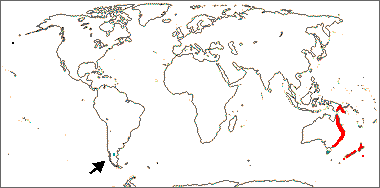Family name: Ripogonaceae Conran & Clifford
Synonym(s): [none]
Common name(s): ripogonum family
*Number of genera/species: 1/6
List of genera records in GRIN-Global
seed
Fruit a berryberry:
an indehiscent, fleshy fruit with one or a few to many seeds. The flesh may be homogenous throughout. Or, if the outer part is hard, firm, or leathery, referred to as an hesperidium. Septa are present in some, and the seeds may be arillate or with a fleshy testa. , 8–20 mm long, globoseglobose:
, 8–20 mm long, globoseglobose:
3D shape—more or less spherical to ovoidovoid:
to ovoidovoid:
3D shape—ovate , roundround:
, roundround:
2D shape—orbiculate; circular or triangulartriangular:
or triangulartriangular:
2D shape—three relatively straight sides with distinct corners; more angular than teardrop-shaped in transection, stylar remnantsstyle base:
in transection, stylar remnantsstyle base:
remnant of a style persistent, sometimes beakedbeak:
persistent, sometimes beakedbeak:
a usually firm, terminal appendage, sometimes tapered , with one to few seeds. Pericarppericarp:
, with one to few seeds. Pericarppericarp:
fruit wall or fruit coat
black or red, fleshy, smooth, sometimes pubescentpubescent:
surface relief—bearing hairs
.
Seeds ovoidovoid:
3D shape—ovate or polygonalpolygonal:
or polygonalpolygonal:
angular
, tereteterete:
approximately circular in cross section; width and thickness approximately equal
 in transection, 5–12 mm long. Seed coat yellow to brown, thick (fleshy).
in transection, 5–12 mm long. Seed coat yellow to brown, thick (fleshy).
Embryo very small, linearlinear:
(shape) long, narrow, and uniform in width; (of embryo) embryo is straight and much longer than wide .
.
Endosperm copious, very hard.
| Fruit | |
| Type | berryberry: an indehiscent, fleshy fruit with one or a few to many seeds. The flesh may be homogenous throughout. Or, if the outer part is hard, firm, or leathery, referred to as an hesperidium. Septa are present in some, and the seeds may be arillate or with a fleshy testa.  |
| Size range | 8–20 mm long |
| Shape(s) | globoseglobose: 3D shape—more or less spherical  , ovoidovoid: , ovoidovoid:3D shape—ovate  |
| Texture | fleshy |
| Surface relief | smooth, sometimes pubescentpubescent: surface relief—bearing hairs |
| Color(s) | black, red |
| Unique features | Black or red berriesberry: an indehiscent, fleshy fruit with one or a few to many seeds. The flesh may be homogenous throughout. Or, if the outer part is hard, firm, or leathery, referred to as an hesperidium. Septa are present in some, and the seeds may be arillate or with a fleshy testa.  , sometimes pubescentpubescent: , sometimes pubescentpubescent:surface relief—bearing hairs , with yellow to brown seeds. |
| Seed | |
| Size range | 5–12 mm long |
| Shape(s) | ovoidovoid: 3D shape—ovate  , polygonalpolygonal: , polygonalpolygonal:angular |
| Color(s) | yellow, brown |
| Other | |
| Embryo | very small, linearlinear: (shape) long, narrow, and uniform in width; (of embryo) embryo is straight and much longer than wide  |
| Nutritive tissue | endosperm copious, very hard |
Australia, Papua New Guinea, New Zealand.

Distribution map courtesy of Angiosperm Phylogeny Website.
Baskin and Baskin 2021Baskin and Baskin 2021:
Baskin C and Baskin J. 2021. Relationship of the lateral embryo (in grasses) to other monocot embryos: A status up-grade. Seed Science Research 31 (3): 199-210. doi:10.1017/S0960258521000209; Dahlgren et al. 1985Dahlgren et al. 1985:
Dahlgren RMT, Clifford HT, and Yeo PF. 1985. The families of the monocotyledons: structure, evolution, and taxonomy. Springer-Verlag, Berlin. 520 pp.; Flora of Australia 2021+Flora of Australia 2021+:
Flora of Australia. Australian Biological Resources Study, Canberra. Accessed January 2021–March 2024. URL: http://www.ausflora.org.au; Kirkbride et al. 2006Kirkbride et al. 2006:
Kirkbride JH, Jr, Gunn CR, and Dallwitz MJ. 2006. Family guide for fruits and seeds, vers. 1.0. Accessed September 2020-January 2022. URL: https://nt.ars-grin.gov/seedsfruits/keys/frsdfam/index.cfm .; Kubitzki et al. 1990+Kubitzki et al. 1990+:
Kubitzki K et al., eds. 1990+. The families and genera of vascular plants. 7+ vols. Berlin etc.; Takhtajan 2009Takhtajan 2009:
Takhtajan A. 2009. Flowering plants: Second edition. Springer Nature, Switzerland. 871 pp.; Watson and Dallwitz 1992+Watson and Dallwitz 1992+:
Watson L and Dallwitz MJ. 1992+. The families of flowering plants: descriptions, illustrations, identification, and information retrieval. Version: 6th Accessed September 2020-September 2022. URL: delta-intkey.com
*The number of genera and species is based on Christenhusz and Byng 2016Christenhusz and Byng 2016:
Christenhusz MJM and Byng JW. 2016. The number of known plant species in the world and its annual increase. Phytotaxa 261 (3): 201-217. https://doi.org/10.11646/phytotaxa.261.3.1, which may differ from the number of genera in GRIN-Global.